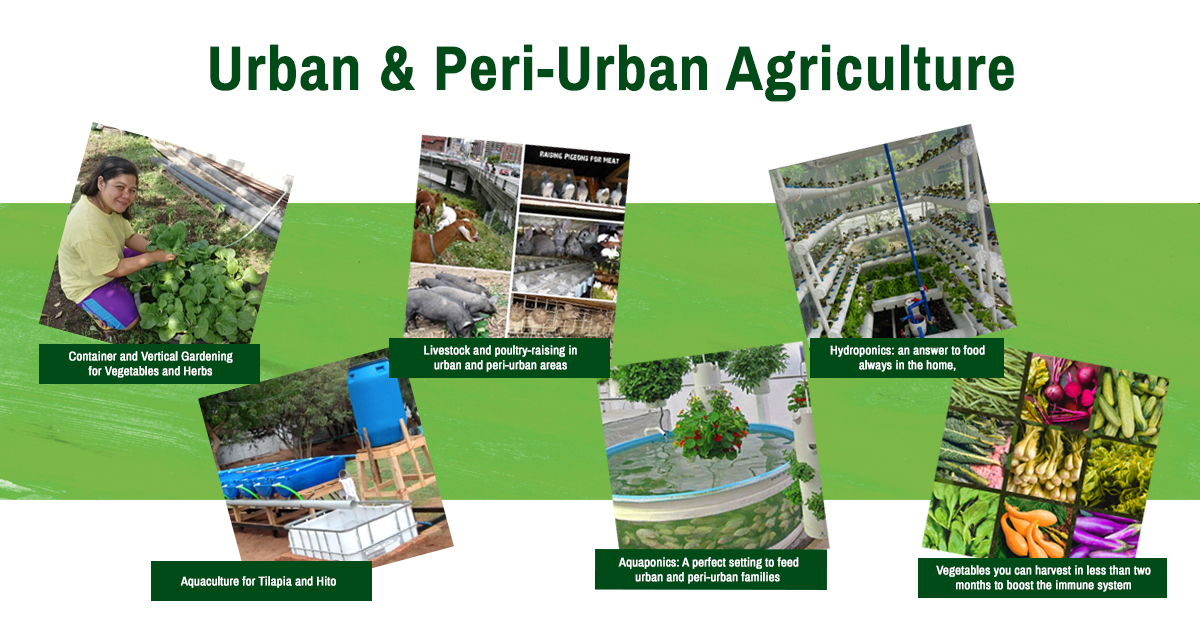by Myer G. Mula, Ph.D.
It has been projected that more than half of the world’s population will live in cities in a few years and food security will be a perennial challenge that will confront humanity. This situation will make it more difficult to improve the living conditions of the urban poor specifically during crises such as earthquakes, typhoons, cyclones, and the recently CoViD 19 pandemic, where agricultural products are restricted to enter the urban markets.
With the advent of the pandemic, where health is considered a precious resource such in the case of highly urbanized cities of the country (i.e. Metro Manila, Cebu, Baguio, Davao) and the 30 poorest of the poor provinces covered by the Special Area for Agricultural Development (SAAD) Program of the Department of Agriculture, the enormous potential of urban and peri-urban agriculture (UPA) as a sustainable food source is life-changing.
Urban and peri-urban agriculture has existed in various forms and occurs within and surrounding the boundaries of major cities. It was first documented during the Aztec and Mayan civilizations and in prehistoric Jericho in various forms and locations. An advantage of UPA is being in control of the type of crops, animals, and fish to raise considering the household needs and availability of resources.
We all know that people in the countryside continue to flock the conurbation due to economic, social and creative opportunities. However, urbanization also presents major challenges. In the Philippines, urbanization is rapidly increasing with almost 49% of Filipinos now living in urban areas, and by 2030, that number is expected to jump to 77%. Metro Manila, for instance, has more than 12 million inhabitants, many living in dense communities with large building structures. Traffic congestion, rising fuel prices, high cost of basic commodities, and poor road infrastructure have produced a problem in moving agricultural products from rural areas to urban markets where a lot of people reside and where the food is consumed more.
In this scenario, the driving force appears to be increased migration from rural to urban areas, along with increased demand for crop-, animal-, and fish-based foods. At the same time, there is an urbanization of poverty, the challenges facing global agricultural production and food security, and malnutrition is a prevailing problem among the urban poor. The changing state of agriculture over time led to farming communities and policymakers to search for more remunerative and viable production portfolios during the time of crisis.
Urban and peri-urban agriculture has seen in recent years a clear shift mainly to produce vegetables for food and ornamentals for beautification to raising animals and fish. At present, growing crops and raising animals, and fish in urban and peri-urban areas is a common practice in many low-income countries and an important survival strategy for the urban poor while viewing economic return estimated to be comparable to the income of unskilled construction workers.
Crop, livestock, poultry, and fish will offer an opportunity to improve the quality of life through the accessibility of food, improve nutrition, and increase cash income from sales. Improved nutrition is attained as these households are likely to consume a diverse and nutritious diet to enhance their immune system. As diets change, as a consequence of urbanization and rising income, urban production may also, to some extent, meet the increased urban demand for food, and may complement rural and foreign sources of food supply to cities. It has been estimated that urban and peri-urban production only represents 20 – 30 % of the country’s total food production while 80% of food stock in the urban areas is supplied from rural areas and imports.
The collective benefits from UPA include among others solving transportation problems, air pollution, and converting urban waste into fertilizer. To ensure the sustainability of production, UPA productivity needs an integrated production model through agricultural technology innovation (i.e. hydroponics and aquaponics) that will create a resilient food systems to accelerate the realization of food security. Given the potential benefits of UPA, government policies need to provide access to electricity, clean irrigation water, while also protecting and improving public health.
In conclusion, the SAAD program has initiated the implementation of UPA including documenting and releasing 6 articles in advocating food availability and accessibility in support to DA’s Plant, Plant, Plant Program namely: Container and Vertical Gardening for Vegetables and Herbs, Aquaculture for Tilapia and Hito, Livestock and poultry-raising in urban and peri-urban areas, Hydroponics: an answer to food always in the home, Aquaponics: A perfect setting to feed urban and peri-urban families, and Vegetables you can harvest in less than two months to boost the immune system. ###
References:
- Basingan D and Ilagan K. 2012. Urbanization by the numbers. Philippine Center for Investigative Journalism. Retrieved from: http://pcij.org/stories/ urbanization-by-the-numbers/
- Deelstra T and Girardet H. 2005. Urban agriculture and sustainable cities. RUAF Foundation Growing Cities.
- Food and Agriculture Organization. 2017. The future of food and agriculture – Trends and challenges. Rome.
- Food and Agriculture Organization. 2001. Urban and Peri-Urban Agriculture. The Special Programmed for Food Security. Final Report. July.
- Mula MG and Arro J. 2020. Urban Agriculture: Coping with Crisis Towards Food Security (Part 4: Hydroponics: an answer to food always in the home). Special Area for Agricultural Development (SAAD) Program, Department of Agriculture. SAADvocacy, 2(7):6-8. ISSN 2718-9791.
- Srivastava N and Shaw R. 2016. Enhancing City Resilience Through Urban-Rural Linkages. Urban Disasters and Resilience In Asia. Pages 113-122. ISBN 9780128021699.


Comments (0)